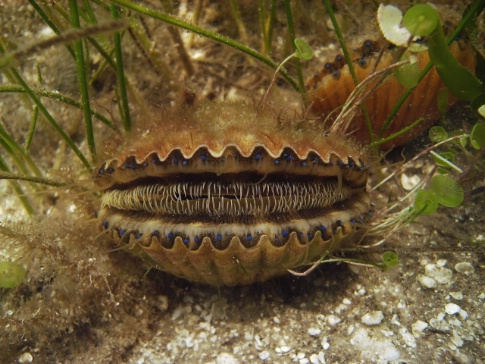
by Rick O'Connor | Aug 14, 2020
For some of us this is an annual gathering no different that Thanksgiving or Christmas. The family all knows the gig – “Kids get your things together – we’re heading to St. Joe!”
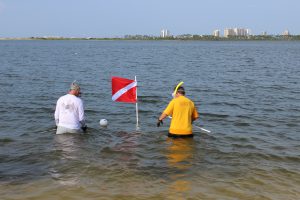
Scallopers heading out for a day of fun.
Photo: Molly O’Connor
For others, it is something we do when we can – the stars all align with work and we decide “Hey, Let’s go scalloping!”
For some, it is a new thing we want to get involved in. It is a fun family activity. Loading up the car with your snorkel gear, maybe choose camping instead of a hotel, maybe just go over for the day – (note: I do not recommend this option – I have done this and it is a LONG day – you will enjoy it more if you stick around and cook your scallops over there).
For those who have NO idea what we are talking about – we are talking about that great Florida family activity of SCALLOPING.
So, what is scalloping you say?
I guess you know by now that it is fun – and it is. Scallops are small bivalves that live in the seagrass beds. You just have to have a mask and snorkel to go find them – and you don’t have to go very deep. They lay right on top of the grass, their little blue eyes staring at you, and you pick them up. OH! they can swim! – not very well, but they can swim! The fun part is that it is a great day on the water, you get to see all sorts of other cool marine life while hunting, everyone is playing and splashing, and the day ends with a really seafood meal – maybe around a campfire. Good times for sure.
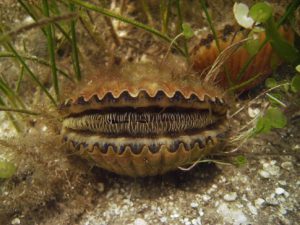
Bay Scallop Argopecten irradians
http://myfwc.com/fishing/saltwater/recreational/bay-scallops/
You may ask – “why do I have to go all the way to Port St. Joe to do this?”
And that would be a good question.
The bay scallop was once found along the entire Gulf coast, and even on part of the east coast, of Florida. There was a commercial fishery for the guy. But, overharvesting, poor water quality, and habitat loss, caused a decline. First, the commercial harvest was stopped. Then areas of the coast, including the Pensacola Bay area, were closed to recreational harvesting. Today there are a few regions in the Big Bend area where you can still scallop. Each region has its own “season” and the closest to us is Port St. Joe in Gulf County. This region extends from Mexico Beach to St. Vincent Island. It opens August 16 and closes September 24.
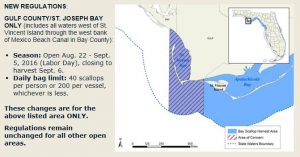
http://myfwc.com/fishing/saltwater/recreational/bay-scallops/
Because it is a managed recreational fishery now – there are some rules.
– Each person is allowed 2 gallons of whole scallop, or 1 pint cleaned.
– Each boat (if you take a boat) is allowed 10 gallons whole, or ½ gallon cleaned.
– Snorkelers are to have a dive flag and be within 100 feet of it at all times.
– A fishing license is required to harvest unless (a) you are exempt from having to have one (see FWC’s website on who is exempt), (b) you are wading – your feet never leave the bottom.
To clean them you only need a knife or flathead screwdriver to pry open the shell. The adductor that opens and closes the shell is the part you eat. Remove the viscera from around it, keep it cold, and cook when you are done. Fried, broiled in butter, there are numerous ways to do this.
It really is a lot of fun, and they are really good to eat.

Prepared properly: One of the finest meals you will ever have.
The “everything you need to know scalloping” FWC page can be found at – https://myfwc.com/fishing/saltwater/recreational/bay-scallops/.
GO HAVE FUN!
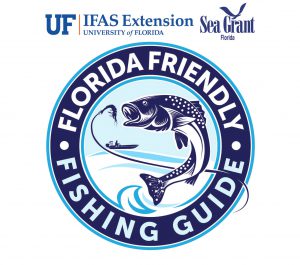
by Laura Tiu | Jul 3, 2020
Fishing is big business in Florida, contributing billions of dollars each year to the state’s economy. Fishing guides are an important part of the fishing industry. Guides provide locals and tourists alike with authentic Florida fishing experiences and memories that last a lifetime. Fishing guides are role models that can teach ethical angling through their onboard behaviors.
The Florida Friendly Fishing Guides Certification was developed by the University of Florida IFAS Extension, Florida Sea Grant, and the Florida Fish and Wildlife Conservation Commission with input from fishing guides. It is a voluntary certification program and involves no regulatory component. The target audience is flats guides, charter boat captains, and head-boat captains and crew. Recreational fishers are welcome to take the course, too.
What will I learn?
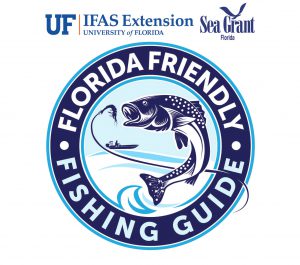 The Florida Sea Grant Florida Friendly Fishing Guide online course teaches best practices for catch and release fishing. Each lesson plan focuses on a different aspect of ethical angling. There are modules on seafood safety, federal and state fisheries management, onboard waste management, and how to teach your customers about the environment.
The Florida Sea Grant Florida Friendly Fishing Guide online course teaches best practices for catch and release fishing. Each lesson plan focuses on a different aspect of ethical angling. There are modules on seafood safety, federal and state fisheries management, onboard waste management, and how to teach your customers about the environment.
One environmental impact of fishing is what we call discard mortality. This is when a caught fish is released but does not survive. You will learn how to increase fish survival, how to identify barotrauma, and how to use descending and venting tools.
Starting July 15, 2020, a descending device will be required for head-boats, charter boats, commercial, and recreational vessels fishing for reef fish in federal waters of the Atlantic Ocean from North Carolina to Florida. The Florida Friendly Fishing Guide course will teach you how to identify barotrauma and select the right tool for sending fish back down to depth! Proper fish handling skills are important because up to 60% of caught fish are released.
The cost is $130 and the course takes about 4 hours to complete. Once you complete the course you receive a welcome package, public listing on the Florida Sea Grant website, and an optional social media promotion. For more information and registration go to https://www.flseagrant.org/florida-friendly-fishing-guide-certification/ or contact your local Florida Sea Grant agent, Laura Tiu, lgtiu@ufl.edu. Florida Friendly Fishing Guide Certification is a state-wide program for all saltwater fishing guides in Florida.

by Sheila Dunning | Jul 3, 2020

Dog Star nights Astro Bob
The “Dog Days” are the hottest, muggiest days of summer. In the northern hemisphere, they usually fall between early July and early September. The actual dates vary greatly from region to region, depending on latitude and climate. In Northwest Florida, the first weeks of August are usually the worst. So, get out before it gets hotter.
In ancient times, when the night sky was not obscured by artificial lights, the Romans used the stars to keep track of the seasons. The brightest constellation, Canis Major (Large Dog), includes the “dog star”, Sirius. In the summer, Sirius used to rise and set with the sun, leading the ancient Romans to believe that it added heat to the sun. Although the period between July 3 and August 11 is typically the warmest period of the summer, the heat is not due to the added radiation from a far-away star, regardless of its brightness. The heat of summer is a direct result of the earth’s tilt.
Life is so uncertain right now, so, most people are spending less time doing group recreation outside. But, many people are looking to get outside Spending time outdoors this time of year is uncomfortable, potentially dangerous, due to the intense heat. So, limit the time you spend in nature and always take water with you. But, if you are looking for some outdoor options that will still allow you to social distance,
try local trails and parks. Some of them even allow your dog. Here are a few websites to review the options: https://floridahikes.com/northwest-florida and https://www.waltonoutdoors.com/all-the-parks-in-walton-county-florida/northwest-florida-area-parks/ Be sure to check if they are allowing visits, especially those that are connected to enclosed spaces.
Other options may include zoos and aquariums: www.tripadvisor.com/Attractions-g1438845-Activities-c48-Florida_Panhandle_Florida.html
Or maybe just wander around some local plant nurseries:
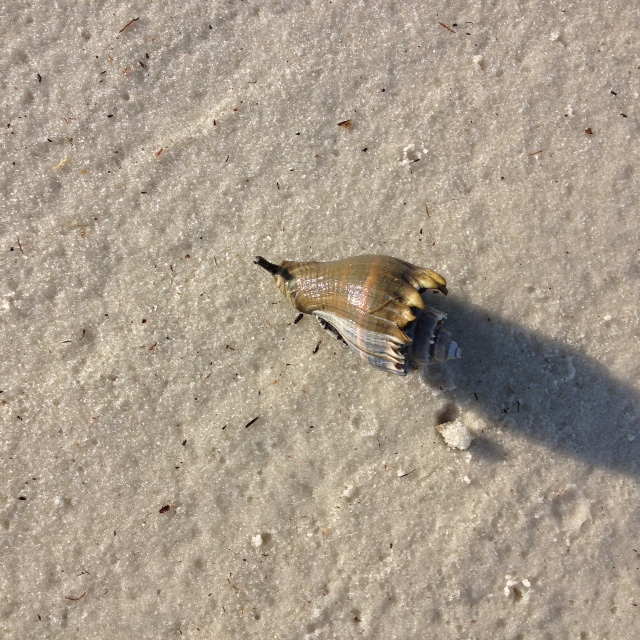
by Rick O'Connor | Jun 11, 2020
One of the largest groups of invertebrates in the Gulf are the Mollusk… what many call “seashells”. Shell collecting has been popular for centuries and, in times past, there were large shows where shells from around the world were traded. Almost everyone who visits the beach is attracted to, and must take home, a seashell to remind them of the peace beaches give us. Many are absolutely beautiful, and you wonder how such small simple creatures can create such beauty.
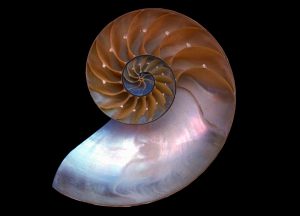
One of the more beautiful shells from the sea – the nautilus.
Photo: Wikipedia
Well, first – not all mollusk are small. There are cephalopods that rival the size of some sharks and even whales.
Second, many are not that simple either. Some cephalopods are quite intelligent and have shown they can solve problems to reach their food.
But beautiful they are, and the colors and shapes are controlled by their DNA. Just amazing.
There are possibly as many as 150,000 different species of mollusks. These species are divided into 8-9 classes (depending which book you read) but for this series on Embracing the Gulf we will focus on only three. First up – the snails (Class Gastropoda).
There are an estimated 60,000 – 80,000 species of gastropods, second only to the insects. They are typically called snails and slugs and are different in that they produce a single coiled shell. The shell is made of calcium carbonate (limestone) and is excreted from tissue called the mantle. It covers their body and continues to grow as they do. The shell coils around a linear piece of shell called the columella. Most coil to the right, but some to the left – sort of like right and left-handed people. There is an opening in the shell where the snail can extend much of its body – this is called the aperture – and some species can close this off with a bony plate called an operculum when they are inside. Some snail shells have a thin extension near the head that protects the siphon – a tube that acts like a snorkel drawing water in and out of the body.
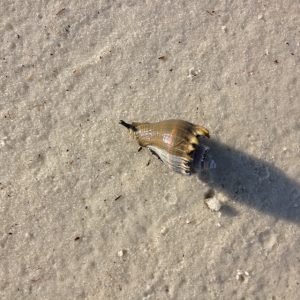
The black siphon can be seen in this crown conch crawling across the sand.
Photo: Franklin County Extension.
They have pretty good eyes and excellent sense of smell. They possess antenna, which can be tactile or sense chemicals in the water (smelling) to help provide information to a simple brain.
They are slow – everyone knowns this – but they really don’t care. Their thick calcium carbonate shells protect them from most predators in the sea… but not all.
Their cousins the slugs either lack the shell completely, or they have a remnant of it internally. You would think “what is the point of an internal shell?” – good question. But the slugs have another defense – they are poisonous. Venomous and poisonous are two different things. Being poisonous means you have a form of toxin within your body tissue. If a predator eats you – they will get very sick, maybe die. But you die as well, so… Not too worry, poisonous slugs are brightly colored – a universally understood signal to all predators.
There is one venomous snail – the cone snail, of which we have about five species in the Gulf. They possess a stylet at the tip of their siphon (similar to the worms we have been writing about) which they can use as a dart for prey such as fish. Many gastropods are carnivores, but some are herbivores, and some are scavengers.
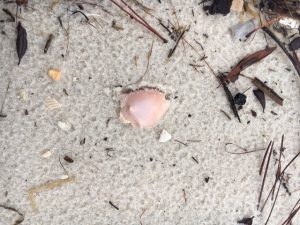
Many shells are found on the beach as fragments. Here you see the fragment of a Florida Fighting Conch.
Photo: Rick O’Connor
Most have separate sexes and exchange gametes in a sack called a spermatophore. Fertilized eggs are often encased in structures that resemble clusters, or chains, of plastic. These are deposited on the seafloor and the young are born with their shell ready for life.
This group is not as popular as a food item as other mollusk but there are some. The Queen Conch is probably of the most famous of the edible snails, and escargot are typically land snails. I am not aware of any edible slugs… and that is good thing.
Some of the more common snails you will find along our portion of the Gulf of Mexico are:
Crown Conch Olive Murex Banded Tulip
Whelks Cowries Bonnets Cerith
Slippers Moon Oyster Drills Bubble
The most encountered slug is the sea hare.
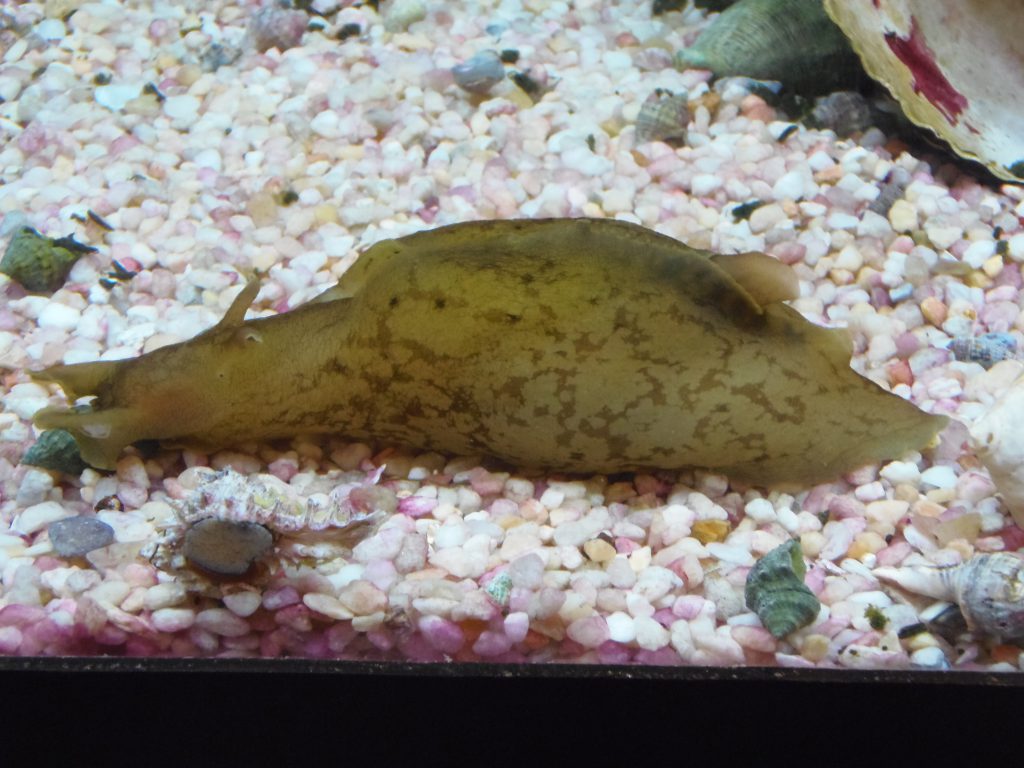
A common sea slug found along panhandle beaches – the sea hare.
I hope you get a chance to do some shelling – I hope you find some complete ones. It is addictive!
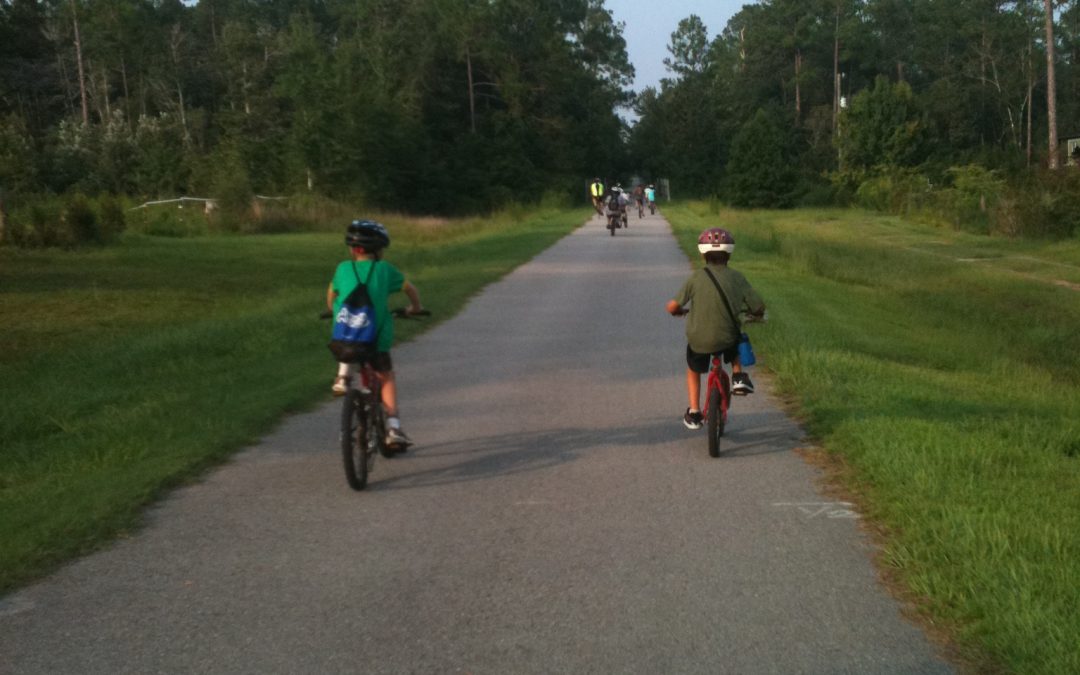
by Carrie Stevenson | May 29, 2020
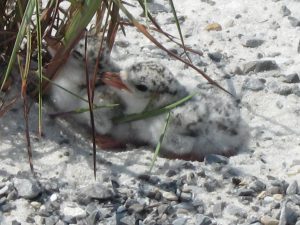
Baby terns on Pensacola Beach are camouflaged in plain sight on the sand. This coloration protects them from predators but can also make them vulnerable to people walking through nesting areas. Photo credit: UF IFAS Extension
The controversial incident recently in New York between a birdwatcher and a dog owner got me thinking about outdoor ethics. Most of us are familiar with the “leave no trace” principles of “taking only photographs and leaving only footprints.” This concept is vital to keeping our natural places beautiful, clean, and safe. However, there are several other matters of ethics and courtesy one should consider when spending time outdoors.
- On our Gulf beaches in the summer, sea turtles and shorebirds are nesting. The presence of this type of wildlife is an integral part of why people want to visit our shores—to see animals they can’t see at home, and to know there’s a place in the world where this natural beauty exists. Bird and turtle eggs are fragile, and the newly hatched young are extremely vulnerable. Signage is up all over, so please observe speed limits, avoid marked nesting areas, and don’t feed or chase birds. Flying away from a perceived predator expends unnecessary energy that birds need to care for young, find food, and avoid other threats.
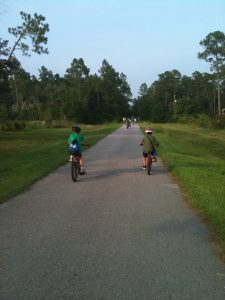
When on a multi-use trail, it is important to use common courtesy to prevent accidents. Photo credit: Carrie Stevenson, UF IFAS Extension
- On a trail, the rules of thumb are these: hikers yield to equestrians, cyclists yield to all other users, and anyone on a trail should announce themselves when passing another person from behind.
- Obey leash laws, and keep your leash short when approaching someone else to prevent unwanted encounters between pets, wildlife, or other people. Keep in mind that some dogs frighten easily and respond aggressively regardless of how well-trained your dog is. In addition, young children or adults with physical limitations can be knocked down by an overly friendly pet.
- Keep plenty of space between your group and others when visiting parks and beaches. This not only abides by current health recommendations, but also allows for privacy, quiet, and avoidance of physically disturbing others with a stray ball or Frisbee.
Summer is beautiful in northwest Florida, and we welcome visitors from all over the world. Common courtesy will help make everyone’s experience enjoyable.
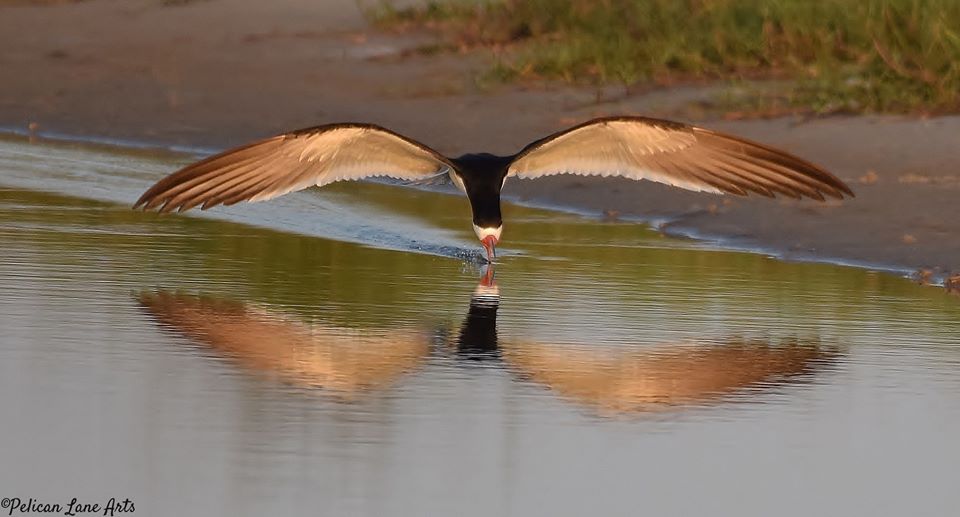
by Chris Verlinde | May 1, 2020
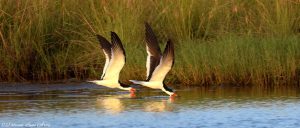
Black Skimmers foraging for fish. Photo Credit: Jan Trzepacz, Pelican Lane Arts.
Black Skimmers and Least Terns, state listed species of seabirds, have returned along the coastal areas of the northern Gulf of Mexico! These colorful, dynamic birds are fun to watch, which can be done without disturbing the them.
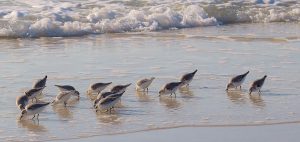
Shorebirds foraging. Photo Credit: Jan Trzepacz, Pelican Lane Arts.
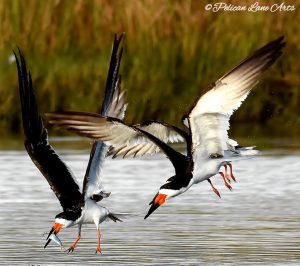
Black Skimmer with a fish. Photo Credit: Jan Trzepacz, Pelican Lane Arts.
What is the difference between a seabird and shorebird?
Among other behaviors, their foraging habits are the easiest way to distinguish between the two. The seabirds depend on the open water to forage on fish and small invertebrates. The shorebirds are the camouflaged birds that can found along the shore, using their specialized beaks to poke in the sandy areas to forage for invertebrates.
Both seabirds and shorebirds nest on our local beaches, spoil islands, and artificial habitats such as gravel rooftops. Many of these birds are listed as endangered or threatened species by state and federal agencies.
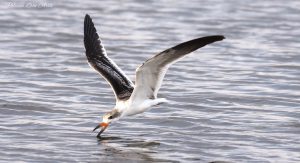
Juvenile Black Skimmer learning to forage. Photo Credit: Jan Trzepacz, Pelican Lane Arts.
Adult black skimmers are easily identified by their long, black and orange bills, black upper body and white underside. They are most active in the early morning and evening while feeding. You can watch them swoop and skim along the water at many locations along the Gulf Coast. Watch for their tell-tale skimming as they skim the surface of the water with their beaks open, foraging for small fish and invertebrates. The lower mandible (beak) is longer than the upper mandible, this adaptation allows these birds to be efficient at catching their prey.
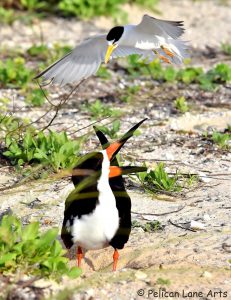
Least Tern “dive bombing” a Black Skimmer that is too close to the Least Tern nest. Photo Credit: Jan Trzepacz, Pelican Lane Arts.
Adult breeding least terns are much smaller birds with a white underside and a grey-upper body. Their bill is yellow, they have a white forehead and a black stripe across their eyes. Just above the tail feathers, there are two dark primary feathers that appear to look like a black tip at the back end of the bird. Terns feed by diving down to the water to grab their prey. They also use this “dive-bombing” technique to ward off predators, pets and humans from their nests, eggs and chicks.
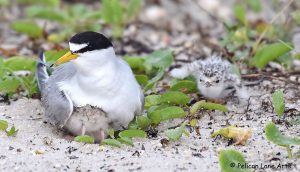
Least Tern with chicks. Photo Credit: Jan Trzepacz, Pelican Lane Arts.
Both Black Skimmers and Least Terns nest in colonies, which means they nest with many other birds. Black skimmers and Least Terns nest in sandy areas along the beach. They create a “scrape” in the sand. The birds lay their eggs in the shallow depression, the eggs blend into the beach sand and are very hard to see by humans and predators. In order to avoid disturbing the birds when they are sitting on their nests, known nesting areas are temporarily roped off by Audubon and/or Florida Fish and Wildlife Conservation Commission (FWC) representatives. This is done to protect the birds while they are nesting, caring for the babies and as the babies begin to learn to fly and forage for themselves.
Threats to these beautiful acrobats include loss of habitat, which means less space for the birds to rest, nest and forage. Disturbances from human caused activities such as:
- walking through nesting grounds
- allowing pets to run off-leash in nesting areas
- feral cats and other predators
- litter
- driving on the beach
- fireworks and other loud noises
Audubon and FWC rope-off nesting areas to protect the birds, their eggs and chicks. These nesting areas have signage asking visitors to stay out of nesting zones, so the chicks have a better chance of surviving. When a bird is disturbed off their nest, there is increased vulnerability to predators, heat and the parents may not return to the nest.
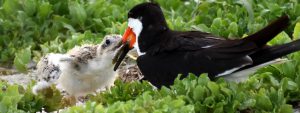
Black Skimmer feeding a chick. Photo Credit: Jan Trzepacz, Pelican Lane Arts.
To observe these birds, stay a safe distance away, zoom in with a telescope, phone, camera or binoculars, you may see a fluffy little chick! Let’s all work to give the birds some space.
Special thanks to Jan Trzepacz of Pelican Lane Arts for the use of these beautiful photos.
To learn about the Audubon Shorebird program on Navarre Beach, FL check out the Relax on Navarre Beach Facebook webinar presentation by Caroline Stahala, Audubon Western Florida Panhandle Shorebird Program Coordinator:
In some areas these birds nest close to the road. These areas have temporarily reduced speed limits, please drive the speed limit to avoid hitting a chick. If you are interested in receiving a “chick magnet” for your car, 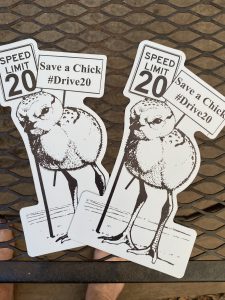 to show you support bird conservation, please send an email to: chrismv@ufl.edu, Please put “chick magnet” in the subject line. Please allow 2 weeks to receive your magnet in the mail. Limited quantities available.
to show you support bird conservation, please send an email to: chrismv@ufl.edu, Please put “chick magnet” in the subject line. Please allow 2 weeks to receive your magnet in the mail. Limited quantities available.


























